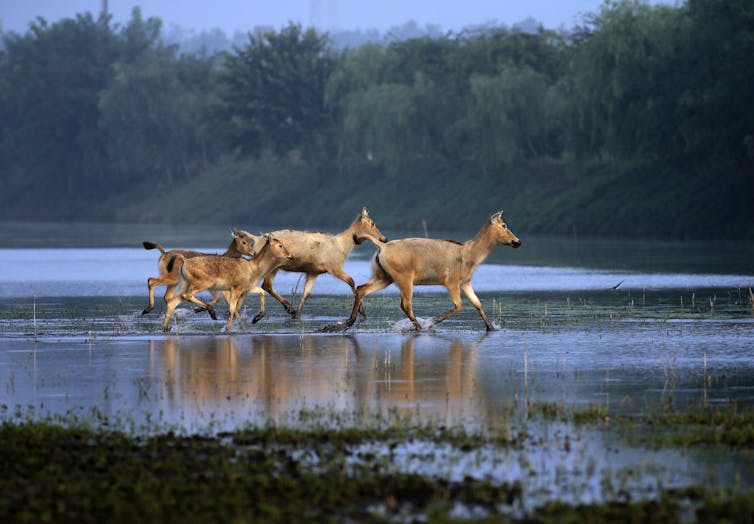This is the first time that Beijing has presided over a major intergovernmental meeting on the environment and wildlife ecologist Vanessa Hull is eager to see the country step into a global leadership role.

Four Père David’s deer (Elaphurus davidianus), also known as milu deer, on a wetland near the Dafeng Milu National Nature Reserve in Jiangsu Province, China. (He Jinghua/VCG via Getty Images)
By Vanessa Hull
University of Florida
 As the world parses what was achieved at the U.N. climate change conference in Egypt, negotiators are convening in Montreal to set goals for curbing Earth’s other crisis: loss of living species.
As the world parses what was achieved at the U.N. climate change conference in Egypt, negotiators are convening in Montreal to set goals for curbing Earth’s other crisis: loss of living species.
Starting on Dec. 7, 196 nations that have ratified the U.N. Convention on Biological Diversity will hold their 15th Conference of the Parties, or COP15. The convention, which was adopted at the 1992 Earth Summit in Rio de Janeiro, is designed to promote sustainable development by protecting biodiversity — the variety of life on Earth, from genes up to entire ecosystems.
Today, experts widely agree that biodiversity is at risk. Because of human activities – especially overhunting, overfishing and altering land — species are disappearing from the planet at 50-to-100 times the historic rate. The United Nations calls this decline a “nature crisis.”
This meeting was originally scheduled to take place in Kunming, China, in 2020 but was rescheduled because of the Covid-19 pandemic, with some negotiations held online. China will lead the deliberations in Montreal and will set the agenda and tone.
This is the first time that Beijing has presided over a major intergovernmental meeting on the environment. As a wildlife ecologist, I am eager to see China step into a global leadership role.
Biodiversity in China
If you ask people where on Earth the greatest concentrations of wild species are found, many will assume it’s in rainforests or tropical coral reefs. In fact, China also is rich in nature. It is home to nearly 38,000 higher plant species – essentially, trees, shrubs and ferns; more than 8,100 species of vertebrate animals; over 1,400 bird species; and 20 percent of the world’s fish species.
Many of China’s wild species are endemic, meaning that they are found nowhere else in the world. China contains parts of four of the world’s global biodiversity hot spots – places that have large numbers of endemic species and also are seriously at risk.
Indo-Burma, the Mountains of Southwest China, Eastern Himalaya and the Mountains of Central Asia are home to species such as the giant panda, Asiatic black bear, the endangered Sichuan partridge, Xizang alpine toad, Sichuan lancehead and golden pheasant.

Giant panda in southwest China. (Vanessa Hull, CC BY-ND)
China’s Conservation Record
Western media coverage of environmental issues in China often focuses on the nation’s severe urban air pollution and its role as the world’s largest greenhouse gas emitter. But China has a vision for protecting nature, and it has made progress since the last global biodiversity conference in 2018.
In that year, Chinese leaders coined the term “ecological civilization” and wrote it into the nation’s constitution. This signaled a recognition that development should consider environmental impacts as well as economic goals.
At that point, China had already created over 2,750 protected areas, covering nearly 15 percent of its total land area. Protected areas are places where there is dedicated funding and management in place to conserve ecosystems, while also allowing for some human activities in designated zones within them.
In 2021 President Xi Jinping announced that China was formally augmenting this system with a network of five national parks covering 88,000 square miles (227,000 square kilometers) — the largest such system in the world.
China also has the fastest-expanding forest area in the world. From 2013 to 2017 alone, China reforested 825 million acres (334 million hectares) of bare or cultivated land — an area four times as large as the entire U.S. national forest system.
At least 10 of China’s notable endangered species are on the path to recovery, including the giant panda, Asian crested ibis and Elliot’s pheasant.
More to Do
Still, China has major areas for improvement. It has underperformed on four of the original Aichi Targets – goals that members of the Convention on Biodiversity adopted for 2011-2020 – including promoting sustainable fisheries, preventing extinctions, controlling invasive alien species and protecting vulnerable ecosystems.
For example, nearly 50 percent of amphibians in China are threatened. Notable species have been declared extinct, including the Chinese dugong, the Chinese paddlefish and Yangtze sturgeon, and the white-handed gibbon.
The Covid-19 pandemic spotlighted China’s central role in legal and illegal wildlife trade, which threatens many endangered mammals, fish, reptiles and birds. In response, China updated its Wildlife Protection Law, originally enacted in 1989.
On Feb. 24, 2020, the law was expanded to impose a near-total ban on trading wildlife for use as food. Now, however, the ban is being revised in ways that could weaken it, such as easing restrictions on captive breeding.
Around 90 percent of China’s grasslands are degraded, as are 53 percent of its coastal wetlands. China has lost 80 percent of its coral reefs and 73 percent of its mangroves since 1950. These challenges highlight the need for aggressive action to protect the nation’s remaining biodiversity strongholds.

The Three Gorges Dam on China’s Yangtze River, visible at lower right, was built to supply electricity and help control flooding. It altered habitats for thousands of plants, animals and fish, including endangered species. (NASA Earth Observatory)
Goals for COP15
The central goal of the Montreal conference is adopting a post-2020 global biodiversity framework. This road map expands on frameworks put forth in past meetings, including the 2010 Aichi Targets.
As the U.N. has reported, nations failed to meet any of the Aichi Targets by 2020, although six goals were partially achieved.
The proposed new framework includes 22 targets to meet by 2030 and four key long-term goals to meet by 2050. They include conserving ecosystems; enhancing the variety of benefits that nature provides to people; ensuring fairness in the sharing of genetic resources, such as digital DNA sequencing data; and solidifying funding commitments.
Many people will be watching to see whether China can successfully lead the negotiations and promote collaboration and consensus. One central challenge is how to pay for the ambitious efforts that the new framework lays out.
Environmental advocates are urging wealthy countries to provide up to $60 billion annually to help lower-income nations pay for conservation projects and curb illegal wildlife trafficking.
China moved in this direction in 2021 when it launched the Kunming Biodiversity Fund and contributed $230 million to it. Pledges from other countries currently total some $5.2 billion per year, mainly from France, the United Kingdom, Japan and the European Union.
China is likely to face questions about its Belt and Road Initiative, a massive infrastructure project that is building railways, pipelines and highways across more than 60 countries. Critics say it is causing deforestation, flooding and other harmful environmental impacts — including in global biodiversity hot spots like Southeast Asia’s Coral Triangle, which contains one of the world’s most important reef systems.
China has pledged to “green” the Belt and Road Initiative going forward, and in 2021, Xi announced a ban on financing new coal power plants overseas, which so far has led to cancellation of 26 plants. This is a start, but China has more to do in addressing Belt and Road’s global impacts.
As home to 18 percent of Earth’s population and the producer of 18.4 percent of global GDP, China has a key role to play in protecting nature. I hope to see it provide bold leadership in Montreal and in the years ahead.![]()
Vanessa Hull is assistant professor of wildlife ecology and conservation at the University of Florida.
This article is republished from The Conversation under a Creative Commons license. Read the original article.
The views expressed are solely those of the author and may or may not reflect those of Consortium News.

I recommend Ms Vanessa Hull, University of Florida read the recent research scholarly article in Monthly Review on China’s ecological achievements and its national goals for an ecological civilizations. Ms Hull’s article seems to be written while gritting her teeth.m
China’s sincerity and efficacy in these areas is yet to be proven, at least to my knowledge, but these are some excellent signs. Among the areas reforested is an enormous section of the Loess Plateau. The reforestation was documented in John Liu’s film Lessons of the Loess Plateau.
In all events, a reduction in Western and particularly US military threats could hardly help but free China and other BRICS nations to engage in ecologically sound economy. Maybe pulling back the military and reducing the IMF and World Bank shell games could enable the US to take part in something similar as well.
At some point, you know, living from forests should become more attractive than living from toxic sludge. It’s not as though a realistic framing of options were a sacrifice.
Sounds good! Kunming, where I lived for 20 years, is a wonderful place. I hope the conference leads to great progress.
I also hope the US does not fake an attack on Taiwan in it’s tiresome efforts to provoke a war with China.